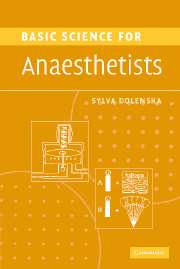Book contents
- Frontmatter
- Contents
- List of abbreviations and symbols
- List of figure captions
- Forewords
- Preface
- Preface to the second edition
- Part 1 Physics, mathematics, statistics, anaesthetic apparatus
- 1 Gas compression, relationship of volume, pressure and temperature
- 2 Real gas compression
- 3 Flow and resistance
- 4 Heat, vaporization and humidification
- 5 Simple mechanics 1: mass, force, pressure
- 6 Simple mechanics 2: work and power
- 7 Mathematical concepts
- 8 Exponentials 1: the curves
- 9 Exponentials 2: properties of exponential decay curve
- 10 Descriptive statistics
- 11 Presentation of data
- 12 Receiver operating characteristic curve
- 13 Gas supply and pressure
- 14 The circle system
- 15 The Mapleson A (Magill) breathing system
- 16 T-pieces
- 17 Lung filling with automatic lung ventilators
- Part 2 Clinical measurement
- Part 3a Physiology: the cardiovascular system
- Part 3b Physiology: the respiratory system
- Part 4 Pharmacology
- Further Reading
- Index
15 - The Mapleson A (Magill) breathing system
from Part 1 - Physics, mathematics, statistics, anaesthetic apparatus
Published online by Cambridge University Press: 13 August 2009
- Frontmatter
- Contents
- List of abbreviations and symbols
- List of figure captions
- Forewords
- Preface
- Preface to the second edition
- Part 1 Physics, mathematics, statistics, anaesthetic apparatus
- 1 Gas compression, relationship of volume, pressure and temperature
- 2 Real gas compression
- 3 Flow and resistance
- 4 Heat, vaporization and humidification
- 5 Simple mechanics 1: mass, force, pressure
- 6 Simple mechanics 2: work and power
- 7 Mathematical concepts
- 8 Exponentials 1: the curves
- 9 Exponentials 2: properties of exponential decay curve
- 10 Descriptive statistics
- 11 Presentation of data
- 12 Receiver operating characteristic curve
- 13 Gas supply and pressure
- 14 The circle system
- 15 The Mapleson A (Magill) breathing system
- 16 T-pieces
- 17 Lung filling with automatic lung ventilators
- Part 2 Clinical measurement
- Part 3a Physiology: the cardiovascular system
- Part 3b Physiology: the respiratory system
- Part 4 Pharmacology
- Further Reading
- Index
Summary
Conway (1985) described the geometry of the Mapleson classification and the behaviour of the breathing systems under conditions of spontaneous and controlled respiration. The Mapleson A (Magill) system (Figure 48) has the fresh gas inlet remote from the subject while the expiratory valve is near the subject. Dead space is shown as the shaded area. This makes the system particularly economic to use during spontaneous respiration.
Figure 49 shows the hypothetical pressure and flow inside the Mapleson A system during expiration. Flow during expiration, which is usually a passive process, is maximal at the beginning of expiration, and it falls off exponentially. Pressure inside the system rises exponentially but at a faster rate than the expiratory flow falls because of accumulation of fresh gas in the system; this rise in pressure is cut off when the expiratory valve opens at 5–6 kPa and this pressure is then maintained until end-expiration. Areas under the flow curve give expired volumes (see the chapter on flow and volume measurement); dead space gas (VD), which is identical in composition to fresh gas is expired first until point A on the graph. When the expiratory valve opens at point B, alveolar gas (VA) beyond that point is vented out. Furthermore, alveolar gas that was deposited inside the system between points A and B (start of alveolar gas expiration and opening of expiratory valve) is after the opening of expiratory valve being pushed out by the fresh gas inflow (VF).
- Type
- Chapter
- Information
- Basic Science for Anaesthetists , pp. 58 - 59Publisher: Cambridge University PressPrint publication year: 2006



